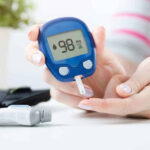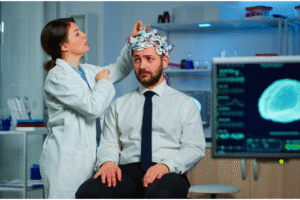Testosterone is the primary male sex hormone and androgen in males. In humans, testosterone plays a key role in the development of male reproductive tissues and the promotion of secondary sexual characteristics such as increased muscle and bone mass, and the growth of body hair.
Common Signs of Low Testosterone
Testosterone deficiency in men is often undiagnosed. Most men do not initially recognize that symptoms such as fatigue, weight gain, or low libido, or even other physical, emotional, and sexual symptoms, could be related to low testosterone levels.
Physical Symptoms
Physical symptoms of low testosterone can vary but often include:
- Fatigue and decreased energy levels
- Unexplained weight gain
- Reduced muscle mass and strength
- Increased body fat
- Thinning hair or hair loss
- Decreased bone density, leading to a higher risk of fractures
Emotional and Psychological Symptoms
Low testosterone doesn’t just affect the body; it can also impact emotional and psychological well-being. Common symptoms include:
- Mood swings and irritability
- Depression or feelings of sadness
- Difficulty concentrating and memory issues
- Decreased motivation and self-confidence
Sexual Symptoms
Sexual health is significantly influenced by testosterone levels. Symptoms of low testosterone in this area include:
- Reduced libido or sex drive
- Erectile dysfunction or difficulty maintaining an erection
- Decreased sexual satisfaction
- Fewer spontaneous erections, such as during sleep
Causes of Testosterone Deficiency
Aging and Testosterone
One of the most common causes of testosterone deficiency is aging. As men get older, their testosterone levels naturally decline. This gradual decrease can lead to various symptoms associated with low testosterone.
Medical Conditions
Several medical conditions can contribute to testosterone deficiency. These include:
- Injury to the testicles
- Low thyroid function
- Obesity
- Diabetes
- Chronic liver or kidney disease
Lifestyle Factors
Certain lifestyle factors can also play a significant role in testosterone deficiency. Poor diet, lack of exercise, and excessive alcohol consumption are some of the key contributors. Additionally, stress and lack of sleep can negatively impact testosterone levels.
Diagnosing Low Testosterone
Diagnosing low testosterone involves a comprehensive approach to understand the underlying causes and determine the best course of action. The process typically includes several steps to ensure an accurate diagnosis.
Medical History and Physical Exam
The first step in diagnosing low testosterone is a thorough medical history and physical exam. The healthcare provider will ask about symptoms, medical history, and lifestyle factors. They will also perform a physical exam to check for signs of low testosterone, such as low libido and erectile dysfunction.
Blood Tests
Blood tests are essential for diagnosing low testosterone. These tests measure the level of testosterone in the blood, usually in the morning when levels are highest. The results can help determine if the testosterone levels are below the normal range.
Interpreting Test Results
Interpreting the results of blood tests is crucial for an accurate diagnosis. The healthcare provider will compare the testosterone levels to the normal range and consider other factors such as age and overall health. If the levels are low, further tests may be needed to identify the cause, such as hormone changes or other medical conditions.
Treatment Options for Low Testosterone
Lifestyle Changes
Lifestyle changes can play a significant role in managing low testosterone levels. Healthy diet and regular exercise are fundamental. Reducing stress and getting adequate sleep can also help improve testosterone levels. Avoiding alcohol and smoking is recommended as these can negatively impact hormone levels.
Medications and Hormone Replacement Therapy
For some individuals, medications and hormone replacement therapy (HRT) may be necessary. Testosterone replacement therapy can be administered through injections, patches, gels, or tablets. However, it’s important to note that a low testosterone level by itself doesn’t need treatment. Testosterone replacement therapy can have side effects, and the long-term risks aren’t known. Only a healthcare provider can determine if this treatment is appropriate.
Alternative Treatments
Some people explore alternative treatments such as herbal supplements and acupuncture. While these methods may offer some benefits, they should be approached with caution. It’s essential to consult with a healthcare provider before starting any alternative treatment to ensure it is safe and effective.
Preventing Testosterone Deficiency
Preventing testosterone deficiency involves a proactive approach to health and wellness. By focusing on key lifestyle factors, individuals can help maintain healthy testosterone levels and reduce the risk of deficiency.
Living with Low Testosterone
Living with low testosterone can be challenging, but there are ways to manage the symptoms and improve quality of life. Managing symptoms effectively often involves a combination of lifestyle changes, medical treatments, and support from healthcare professionals.
Managing Symptoms
To manage symptoms of low testosterone, individuals can:
- Follow a healthy diet and exercise routine to maintain overall health and well-being.
- Consider testosterone replacement therapy to help alleviate symptoms such as fatigue, low libido, and mood swings.
- Work with a healthcare provider to monitor testosterone levels and adjust treatments as necessary.
Support and Resources
Support and resources are crucial for those living with low testosterone. Some options include:
- Joining support groups or online forums to connect with others experiencing similar challenges.
- Seeking counseling or therapy to address emotional and psychological symptoms.
- Utilizing educational materials and resources provided by healthcare professionals to better understand the condition and treatment options.
Long-term Outlook
The long-term outlook for individuals with low testosterone can vary. With proper management and treatment, many people experience significant improvements in their symptoms and overall quality of life. It’s important to maintain regular check-ups with healthcare providers to ensure that treatments remain effective and to make any necessary adjustments. By staying proactive and informed, individuals can better navigate the challenges of living with low testosterone.















